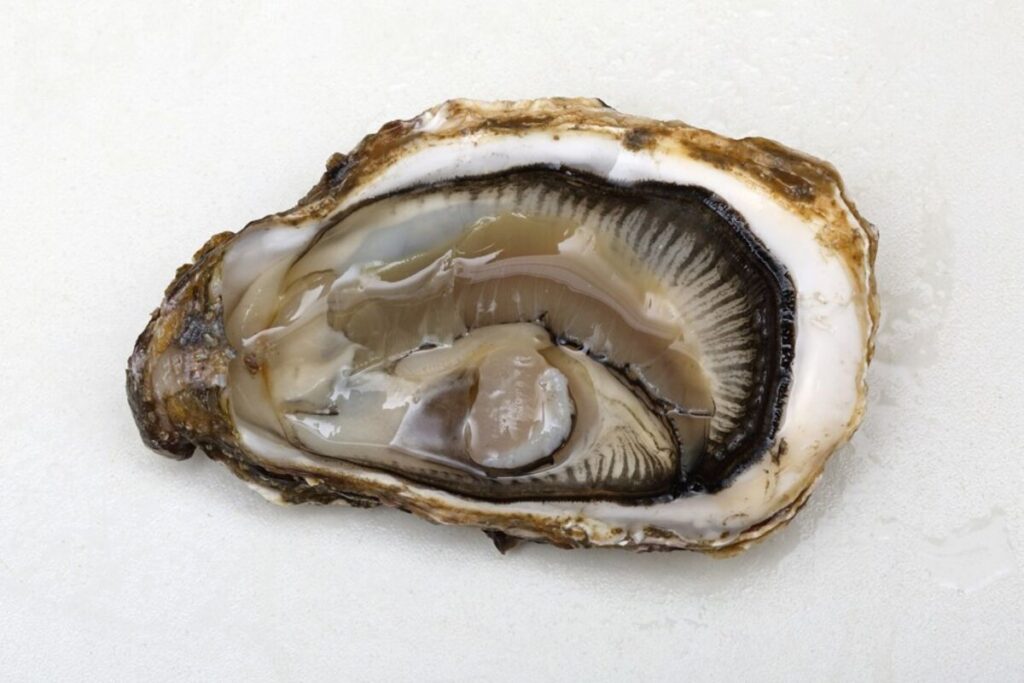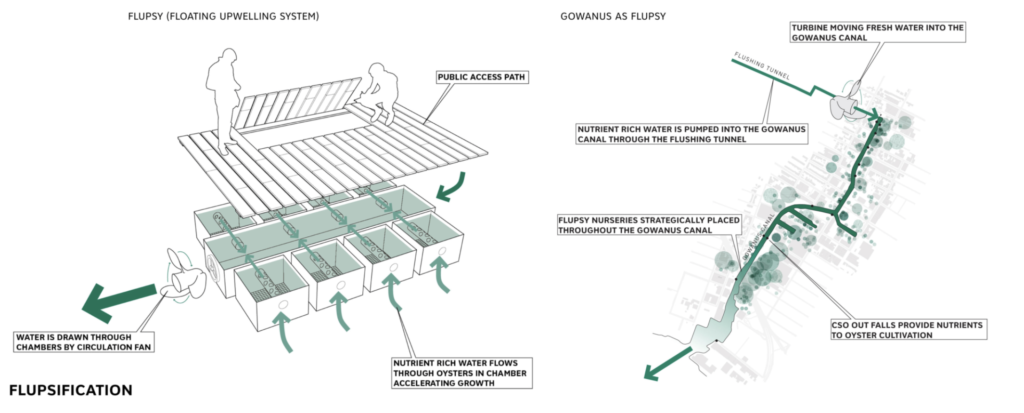Non-Human Architecture
Together, humans, non-humans and the environment create an ecosystem. Within these “natural” relationships, who creates, transforms, supports, or destroys the ecosystem, and why?
Human Intervention:
Capitalism and Architectural Transformation
Before we think about human intervention in the environment, we have to go back to human connection with the environment. Our shift from environmental steward to environmental owner can be conceptualized in relation to the theory of the Tragedy of the Commons.
Initially conceptualized in relation to shared pastoral fields in the English countryside, the Commons is understood as a shared space in which humans, non-human animals, and the environment are mutually supported for the benefit of greater social and environmental equality and prosperity.2 Fundamentally, the Commons is a space in which there is ecosystem equilibrium, and humans, non-humans, and the environment maintain a relationship of respect.

When an imbalanced and inequitable relation is introduced to the Commons, such as capitalism, tragedy occurs. Rather than continuing ecosystem equilibrium, the shared Commons becomes a resource for individual profit, and the relationship between human, non-human, and the environment changes dramatically. 4
Within a capitalist market, humans prioritize their short-term, best economic interests over their role in supporting the larger ecosystem, leading to the exploitation and extinction of ecosystem environments. 5
The Human in the Re-Organized Ecosystem
As a consequence of capitalist relations, the human individual begins to understand themselves as the ultimate force in the ecosystem, opposing the Commons’ natural order of respect and equity.

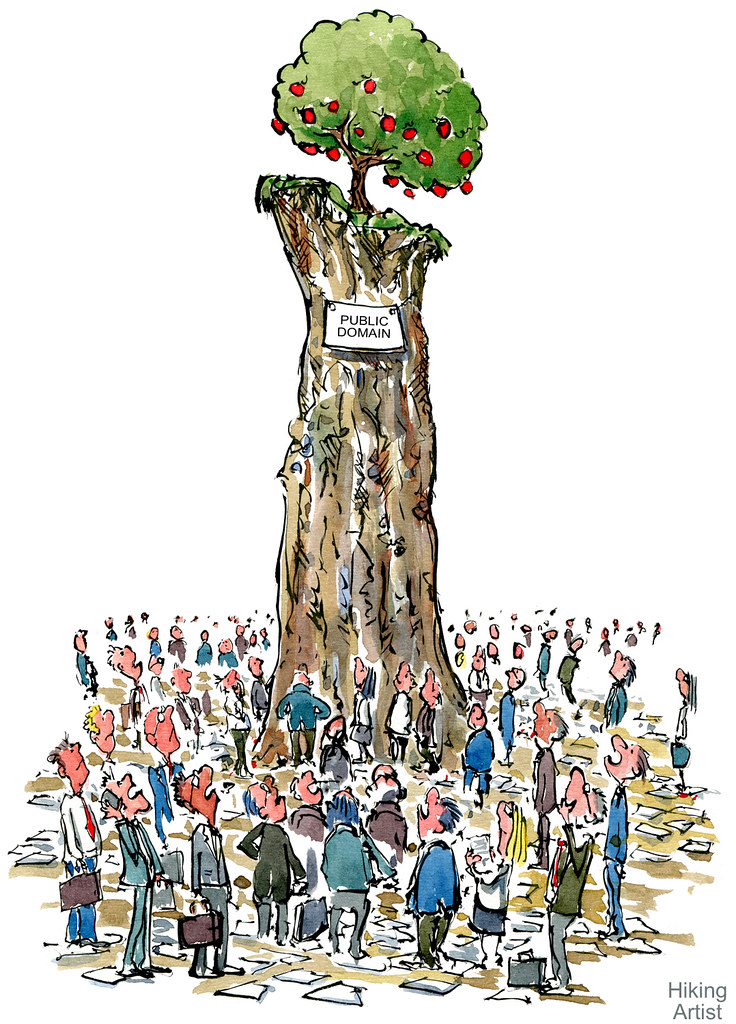
Rather than simply being understood as a feature of the agrarian countryside, the Commons is any space that is capable of ecosystem equilibrium with equitable human, non-human, and environmental relations. We exist in the Commons on a daily basis, yet our actions have warped the potential for ecosystem balance and responsibility.
Oyster-Tecture and Non-Human Intervention:
The Oyster as Ecosystem Actor and Architect
The New York Harbor was once a Commons. Initially an architectural oyster reef that provided filtered water, fresh food stores, and environmental resilience and protection to the Indigenous Lenape people, the Harbor was overrun and extinguished by infiltration of colonization, and eventual enduring acts of capitalism. 8


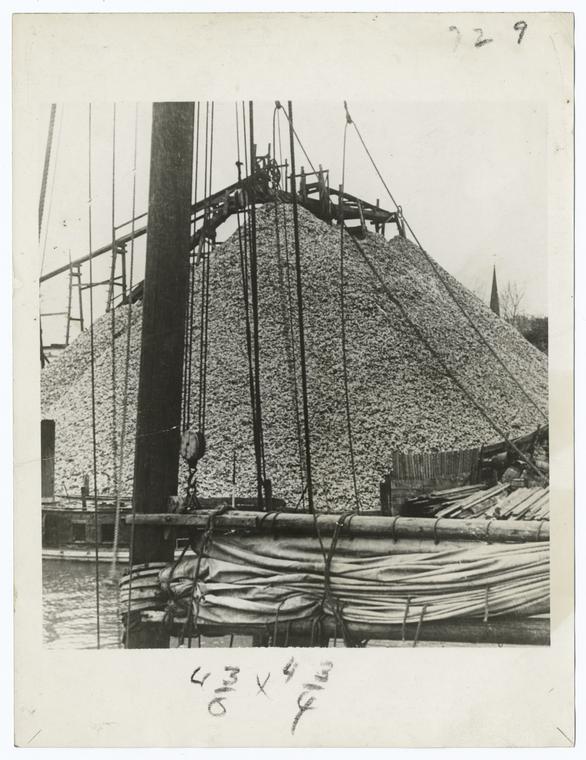
Historically, oysters were the mediating architectural and communal force in guaranteeing ecosystem stability, growth, and equilibrium in the Harbor.
Colonial capitalism, however, reconfigured the human actor from steward of the oyster to owner and consumer of the oyster, stripping the Harbor’s reef and exploiting the potential for equitable human and non-human collaboration.
Kate Orff, founder of SCAPE Landscape Architecture, is looking to redefine the New York Harbor’s ecosystem around the oyster once again, with the introduction of Oyster-Tecture.12
Oysters in the Past, and Oysters in the Future
To re-introduce the oysters to the Harbor, SCAPE Architects are reimagining the past of the architectural reef.
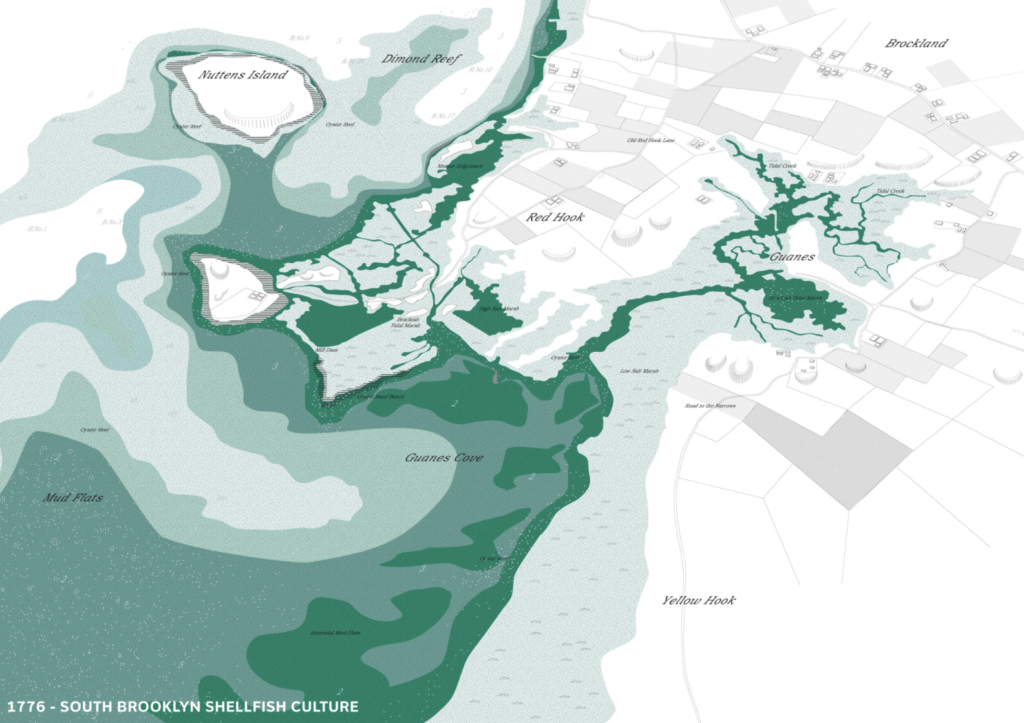

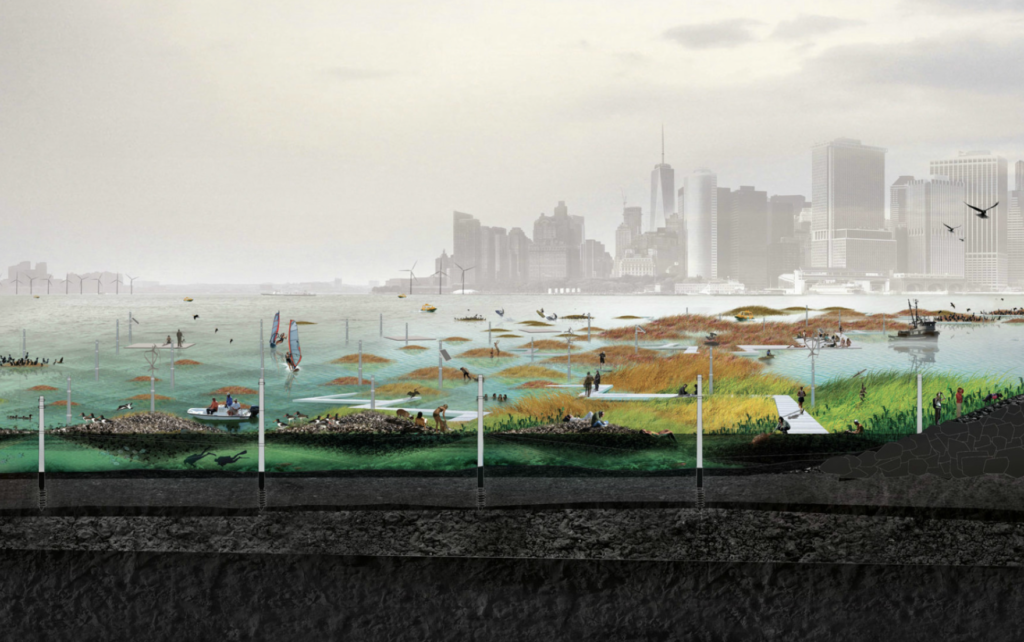
Orff’s Oyster-Tecture, as an act of landscape architecture, will prioritize the needs of the non-human actor, the once-dominant oyster, in order to heal the immediate environment and create an opportunity for future resiliency.
“Oyster-tecture proposes a living reef composed of a woven web of ‘fuzzy rope’ that supports marine growth, generates a 3D landscape mosaic that attenuates waves and cleans millions of gallons of harbor water by harnessing the biotic filtration processes of oyster mussels.”
SCAPE
By prioritizing the oyster’s immediate needs, SCAPE is striving to repair ecosystem communities through the act of reimagining relationships. No peer should be exploited in a shared, common environment.
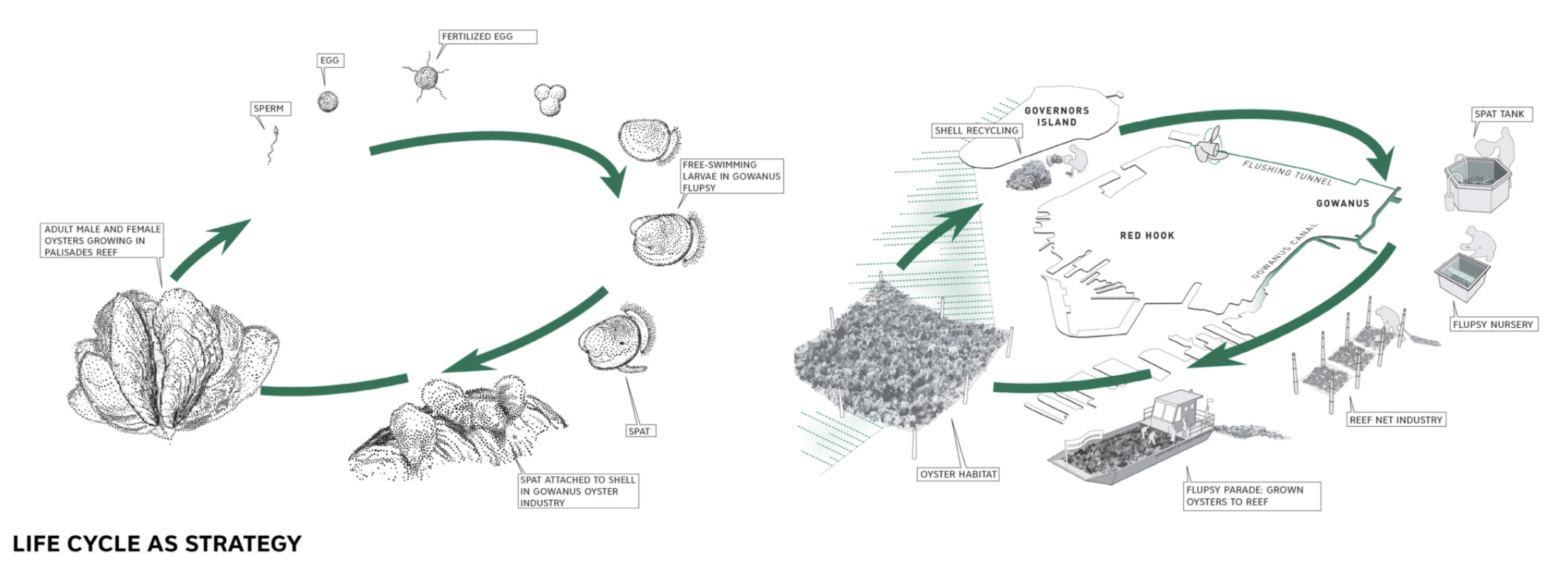
As a result of this re-imagination, and in many ways rectification, of the human role in the common ecosystem, the re-integrated environment has the opportunity to thrive. In acting for the oyster, Orff’s Oyster-Tecture creates conditions for mutual wellbeing.
When histories of colonial capitalism are challenged, ecosystems become spaces of mutuality and resilience.
“Built” and “Natural” Environments:
Who creates these environments? Who do they serve?
In thinking about the architectural and communal potential for “built,” natural environments, I reflected on Alison Shotz’ Topographic Iteration IV currently part of the Wellin Museum’s Dialogues Across Disciplines exhibition.
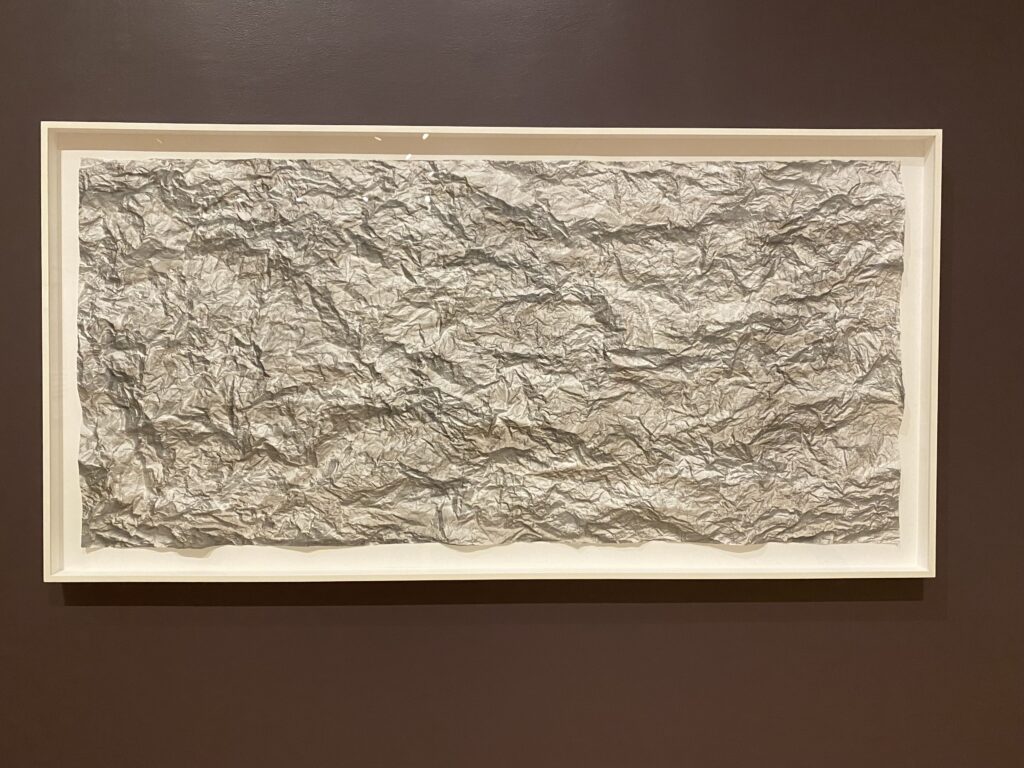
Created through the crumpling, photographing and printing, and re-crumpling of a piece of paper, this piece illustrates the role of construction in the conception of “built” and “natural”environments.22
When we imagine our environments as Common, and our individual human role as integrated within greater ecosystems, we become responsible for the sovereignty and resilience of our fellow non-human peers and our shared environment.
Notes:
- Baloncici, Close up shot of one open raw oyster, Photograph, n.d., https://www.shutterstock.com/image-photo/close-shot-one-open-raw-oyster-299690081.
- Garrett Hardin, “The Tragedy of the Commons,” Science 162, no. 3859 (December 1968), https://www.jstor.org/stable/1724745.
- MHS AP Environmental, “The Tragedy of the Commons,” Illustration Graphic, n.d., https://mhsapes.weebly.com/51-512-reading.html.
- Lynch et al., “Transdisciplinary synthesis for ecosystem science, policy and management: The Australian experience,” Science of the Total Environment (2015), http://dx.doi.org/10.1016/j.scitotenv.2015.04.100.
- Lynch et al., “Transdiciplinary synthesis,” 12.
- Victor M. Ponce, “Hardin’s Tragedy of the Commons Revisited or We are All in the Same Boat,” Illustration, n.d., https://ponce.sdsu.edu/tragedy_revisited.html.
- Frits Alhefeldt, “The Tragedy of the Commons,” Cartoon Illustration, October 16, 2012, https://www.flickr.com/photos/hikingartist/8093644588.
- Thomas Hynes, “Aw Shucks: The Tragic History of New York City Oysters,” Untapped New York, n.d. https://untappedcities.com/2022/08/04/history-new-york-oysters/.
- Berenice Abbott, Oyster Houses, South Street and Pike Slip, Photograph, 1937. https://digitalcollections.nypl.org/items/62a08ba0-9d94-013a-e101-0242ac110003.
- Alfred R. Waud, Oyster Stands in Fulton Market, Print, 1870, https://digitalcollections.nypl.org/items/510d47e0-db1e-a3d9-e040-e00a18064a99.
- Oyster shells for oyster “farming,” Photograph, 1860-1920, https://digitalcollections.nypl.org/items/510d47d9-ab0b-a3d9-e040-e00a18064a99.
- Emmett Fitzgerarld, “Oyster-tecture,” 99% Invisible Podcast (podcast), October 31, 2017, https://99percentinvisible.org/episode/oyster-tecture/.
- SCAPE, “1776 – South Brooklyn Shellfish Culture,” Digital Rendering, https://www.scapestudio.com/projects/oyster-tecture/.
- SCAPE, “2050 – Back to the Future,” Digital Rendering, https://www.scapestudio.com/projects/oyster-tecture/.
- SCAPE, Cityscape Visualization, Digital Rendering, https://www.scapestudio.com/projects/oyster-tecture/.
- SCAPE, “Life Cycle as Strategy,” Digital Rendering, https://www.scapestudio.com/projects/oyster-tecture/.
- SCAPE, Oyster Filtration Illustration, Digital Rendering, https://www.scapestudio.com/projects/oyster-tecture/.
- SCAPE, “Reef Building and Attentuation,” Digital Rendering, https://www.scapestudio.com/projects/oyster-tecture/.
- SCAPE, “Flupsification,” Digital Rendering, https://www.scapestudio.com/projects/oyster-tecture/.
- SCAPE, Visualization of Reintegrated Cityscape, Digital Rendering, https://www.scapestudio.com/projects/oyster-tecture/.
- SCAPE, Oyster Habitat Visualization, Photograph, https://www.scapestudio.com/projects/oyster-tecture/.
- Alison Hotz, Topographic Iteration IV, Multi-Media Sculpture, 2014, https://www.artsy.net/artwork/alyson-shotz-topographic-iteration.
References:
Ahern, Jack. “Novel urban ecosystems: Concepts, definitions and a strategy to support urban sustainability and resilience.” Landscape Architecture Frontiers 4, no. 1 (February 2016). https://link.gale.com/apps/doc/A459715410/AONE?u=nysl_oweb&sid=googleScholar&xid=3590401f.
Amendolare, Nicholas. “What is the tragedy of the commons?” TED-Ed. Streamed on November 21, 2017. Youtube video, https://www.youtube.com/watch?v=CxC161GvMPc.
Apfelbeck, Beate, Robbert P.H. Snep, Thomas E. Hauck, Joanna Ferguson, Mona Holy, Christine Jakoby, J. Scott Maclvor, et al. “Designing wildlife-inclusive cities that support human-animal co-existence.” Landscape and Urban Planning 200 (August 2020). https://doi.org/10.1016/j.landurbplan.2020.103817.
Appelbaum, Alec. “New York’s Climate Plan Really Does Include Oysters.” Bloomberg, December 15, 2015. https://www.bloomberg.com/news/articles/2015-12-15/oysters-will-play-a-key-role-in-new-york-s-climate-plan.
Biss, Eula. “The Theft of the Commons.” The New Yorker, June 8, 2022. https://www.newyorker.com/culture/essay/the-theft-of-the-commons.
Britain Express. “Drystone Walls in England.” Accessed May 5, 2023. https://www.britainexpress.com/History/drystone.htm.
Brown, Robert D., Jennifer Vanos, Natasha Kenny, and Sanda Lenzholzer. “Designing urban parks that ameliorate the effects of climate change.” Landscape and Urban Planning 138 (June 2015): 119-131. https://doi.org/10.1016/j.landurbplan.2015.02.006.
Chiesura, Anna. “The role of urban parks for the sustainable city.” Landscape and Urban Planning 68, no. 1 (May 2004): 129-138. https://doi.org/10.1016/j.landurbplan.2003.08.003.
De Block, Greet and Vera Vicenzotti. “The effects of affect. A plea for distance between the human and non-human.” Journal of Landscape Architecture 2 (2018): 60-69. https://projects.iq.harvard.edu/files/retreat/files/de_block_vicenzotti_jola_2018.pdf.
Desautel Law, host. “Tragedy of the Commons.” Environmentally Speaking Podcast (podcast). April 7, 2022. Accessed on March 31, 2023. https://www.youtube.com/watch?v=L7MggPNANF4.
Eckbo, Garrett. “Is Landscape Architecture?” Landscape Architecture Magazine 73, no. 3 (May/June 1983): 64-65. https://www.jstor.org/stable/44666661.
Eckbo, Garrett. “The city and Nature.” Ekistics 54, no. 325/326/327 (July, Augst-Sept./Oct.-Nov./Dec. 1987): 323-325. https://www.jstor.org/stable/43623020.
Ernwein, Marion. “Bringing Urban Parks to Life: The More-Than-Human Politics of Urban Ecological Work.” Annals of the American Association of Geographers 111, no. 2 (2021): 559-576. http://dx.doi.org/doi:10.1080/24694452.2020.1773230.
FitzGerarld, Emmett, host. “Oyster-tecture.” 99% Invisible Podcast (podcast). October 31, 2017. Accessed April 10, 2023. https://99percentinvisible.org/episode/oyster-tecture/.
Grandia, Liza. “The Tragedy of Enclosures: Rethinking Primitive Accumulation from the Guatemalan Hinterland.” PhD diss., Yale University, 2007.
Grose, Margaret and Mark Frisby. “Mixing ecological science into landscape architecture.” Frontiers in Ecology and the Environment 17, no. 5 (June 2019): 296-297. https://www.jstor.org/stable/26675028.
Gruppuso, Paolo. “Nature as a constellation of activities: movement, rhythm and perception in an Italian national park.” Social Anthropology 28, no. 3 (2020): 629-645. doi:10.1111/1469-8676.12783.
Hagan, Susannah. “Ecological Urbanism.” The Architectural Review, March 16, 2015. https://www.architectural-review.com/essays/ecological-urbanism.
Hardin, Garrett. “The Tragedy of the Commons.” Science 162, no. 3859 (December 1968): 1243-1248. https://www.jstor.org/stable/1724745.
Hill, Dan. “Truly public space rather than technically public space: making ‘platforms for outdoor gathering.’” Medium, August 13, 2021. https://medium.com/iamacamera/truly-public-space-rather-than-technically-public-space-making-platforms-for-outdoor-gathering-fef6f373af4d.
Hynes, Thomas. “Aw Shucks: The Tragic History of New York City Oysters.” Untapped New York, n.d. https://untappedcities.com/2022/08/04/history-new-york-oysters/.
Jorgensen, Dolly. “Rethinking rewilding.” Geoforum 65 (October 2015): 482-488. https://doi.org/10.1016/j.geoforum.2014.11.016.
Klinenberg, Eric. “The Seas are Rising. Could Oysters Help?” The New Yorker, August 2, 2021. https://www.newyorker.com/magazine/2021/08/09/the-seas-are-rising-could-oysters-protect-us.
KOS, Drago. “Nature in the city or the city in nature?” Urbani Izziv 19, no. 2 (2008): 129-132. https://www.jstor.org/stable/24906037.
Lenzholzer, Sanda and Robert D. Brown. “Climate-responsive landscape architecture design education.” Journal of Cleaner Production 61 (December 2013): 89-99. https://doi.org/10.1016/j.jclepro.2012.12.038.
Lynch, A.J.J., R. Trackway, A. Specht, P.J Bergs, S. Brisbane, E.L. Burns, M. Byrne, et al. “Transdisciplinary synthesis for ecosystem science, policy and management: The Australian experience.” Science of the Total Environment (2015). http://dx.doi.org/10.1016/j.scitotenv.2015.04.100.
McArdle, Megan. “Property Rights and the Tragedy of the Commons.” The Atlantic, May 22, 2012. https://www.theatlantic.com/business/archive/2012/05/property-rights-and-the-tragedy-of-the-commons/257549/.
Mostafavi, Mohsen. “Why Ecological Urbanism? Why Now?” Harvard Design Magazine 1, no. 32 (2010). https://www.harvarddesignmagazine.org/issues/32/why-ecological-urbanism-why-now.
Muller, Brook. “New Horizons for Sustainable Architecture: Hydro-Logical Design for the Ecologically Responsive City.” Nature and Culture 13, no. 2 (Summer 2018): 189-207. https://www.jstor.org/stable/26889015.
Musacchio, Laura R. “Metropolitan Landscape Ecology: Using Translational Research to Increase Sustainability, Resilience, and Regeneration.” Landscape Journal 27, no. 1 (January 2008): 1-8. https://doi.org/10.3368/lj.27.1.1.
Niesner, Chase A., Rachel V. Blakey, Daniel T. Blumstein and Eric S. Abelson. “Wildlife Affordances of Urban Infrastructure: A Framework to Understand Human-Wildlife Space Use.” Frontier in Conservation Science 2 (November 2021). https://doi.org/10.3389/fcosc.2021.774137.
Nigro, Carmen. “History on the Half-Shell: The Story of New York City and Its Oysters.” New York Public Library. Accessed May 3, 2023. https://www.nypl.org/blog/2011/06/01/history-half-shell-intertwined-story-new-york-city-and-its-oysters.
Orff, Kate. “Re-building eco-infrastructure: Kate Orff at TEDxGowanus.” TEDx Talks. Streamed on March 10, 2014. Youtube video, https://www.youtube.com/watch?v=NZPT5mgzOCU.
Orff, Kate. “What is Design Now? Unmaking the Landscape.” Architectural Design 90, no. 1 (January 2020): 94-99. https://doi.org/10.1002/ad.2531.
Pickett, Steward T.A., Brian McGrath, M.L. Cadenasso, and Alexander J. Felson. “Ecological resilience and resilient cities.” Building Research & Information 42, no. 2 (December 2013): 143-157. https://doi.org/10.1080/09613218.2014.850600.
SCAPE. “Oyster-tecture.” Accessed April 10, 2023. https://www.scapestudio.com/projects/oyster-tecture/.
Shotz, Alison. Topographic Iteration IV, 2014. Wellin Museum of Art, Hamilton College. https://www.artsy.net/artwork/alyson-shotz-topographic-iteration.
Spiliakos, Alexandra. “Tragedy of the Commons: What it is and 5 examples.” Harvard Business School Online, February 6, 2019. https://online.hbs.edu/blog/post/tragedy-of-the-commons-impact-on-sustainability-issues.
Spirn, Anne Whiston. “Ecological Urbanism: A Framework for the Design of Resilient Cities.” In Resilience in Ecology and Urban Design, edited by Steward Pickett, Mary Cadenasso, and Brian McGrath. Springer, 2013.
Tyler, Stephen, and Marcus Moench. “A framework for urban climate resilience.” Climate and Development 4, no. 4 (January 2012): 311-326. https://doi.org/10.1080/17565529.2012.745389.
Villanueva, George, Carmen Gonzalez, Minhee Son, Evelyn Moreno, Wenlin Liu, and Sandra Ball-Rokeach. “Bringing local voices into community revitalization: engaged communication research in Urban planning.” Journal of Applied Communication Research (2017). http://dx.doi.org/10.1080/00909882.2017.1382711.
Yi-xi, Weng and Sun Ying. “The Role of the Landscape Architect in the 21st Century Fight against Climate Change.” International Journal of Liberal Arts and Social Science 7, no. 10 (November 2019): 27-35. https://ijlass.org/articles/7.10.3.27-35.pdf.
